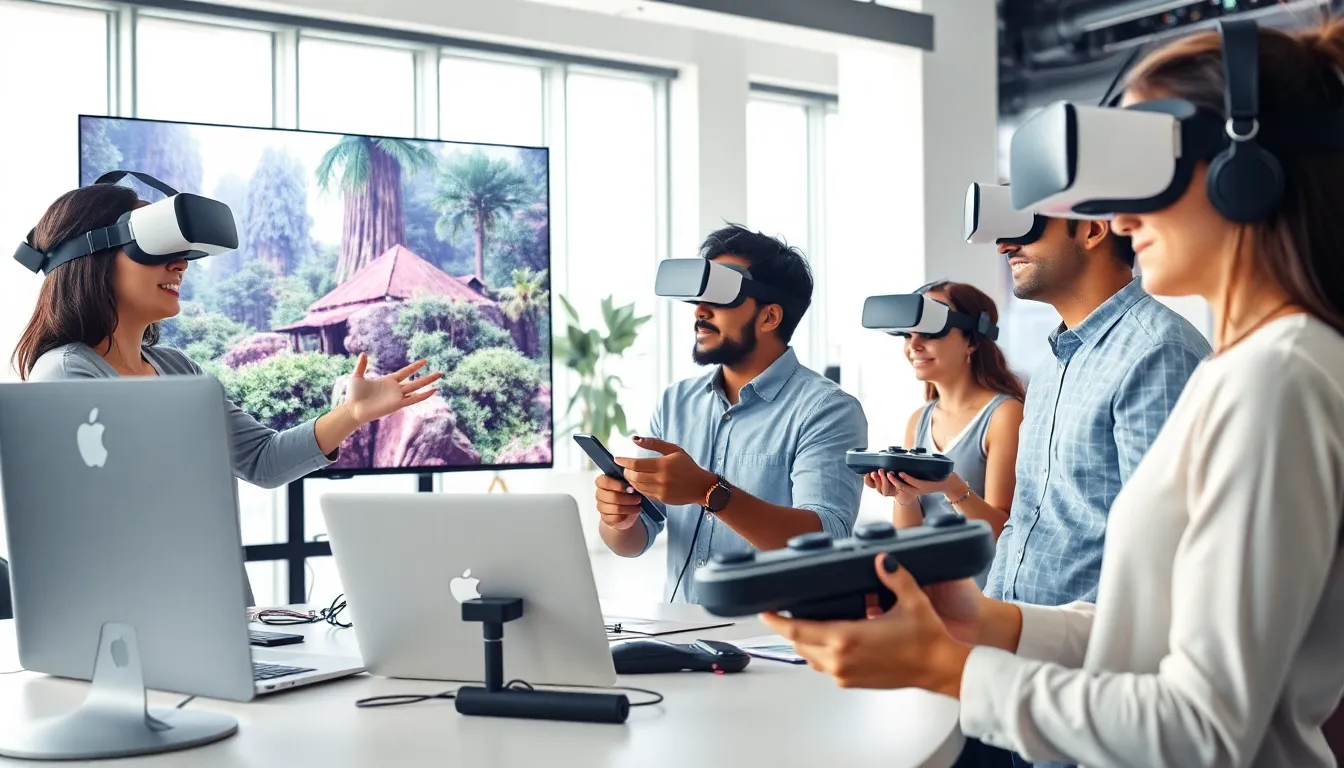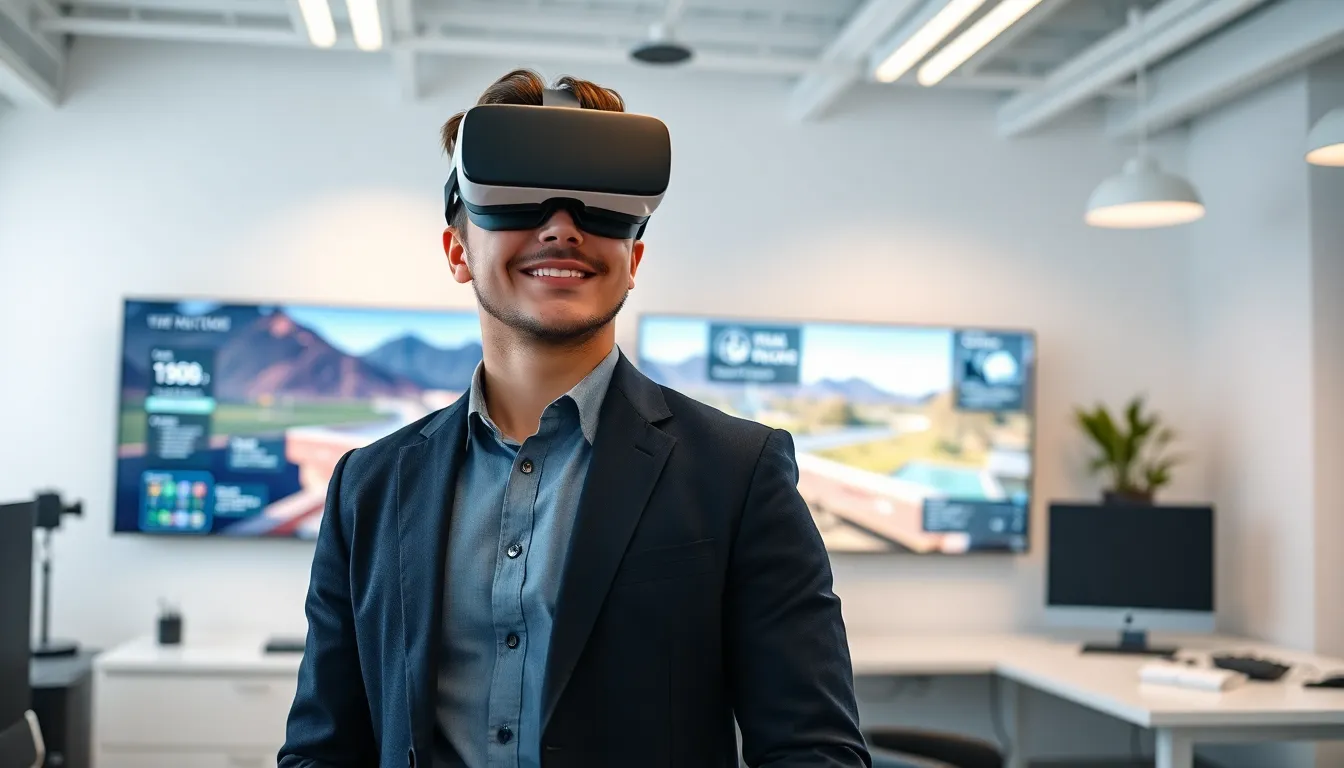Table of Contents
ToggleEmbrace the wild world of Virtual Reality (VR). Imagine wandering through a digital landscape where the rules of physics are just polite suggestions. VR isn’t just sci-fi anymore: it’s transforming how we live, work, and play. As industries from gaming to healthcare jump on the VR bandwagon, understanding the nuts and bolts of its development is more important than ever. Buckle up. We’re about to explore everything from the tech behind the magic to the challenges developers face, all while keeping it light and accessible. Ready to immerse?
Understanding Virtual Reality

Virtual Reality (VR) simulates a complete, immersive experience through technology. Using headsets, gloves, and specialized controllers, users can step into entirely new environments. Picture this: You put on a VR headset and instantly find yourself in a lush rainforest or amidst the stars in an expansive galaxy, all without leaving your living room.
This immersion is created by combining digital visuals, sounds, and even haptic feedback to engage multiple senses, making the experience feel more real than ever. But it’s not just about cool graphics. At its core, VR is about creating a viable simulation that interacts with human behavior in intuitive ways. As developers, they must focus on story arcs, interactivity, and accessibility to ensure users can navigate and enjoy their crafted worlds.
The Importance Of Virtual Reality In Various Industries
Virtual Reality is making waves across various sectors, revolutionizing the way businesses operate and engage with their audiences. In education, students can explore ancient civilizations or conduct complex experiments without any risks. Imagine learning about the solar system by soaring between planets.
In healthcare, VR is used for training medical professionals, providing realistic simulations of surgeries that help them hone their skills before going hands-on. In real estate, potential buyers can enjoy virtual walkthroughs of properties, providing a completely new level of convenience. Even in marketing, brands employ VR to create engaging advertisements that draw consumers into their stories. Each industry showcases VR’s diverse applications, proving that its impact is profound and far-reaching.
Key Technologies In Virtual Reality Development
Behind every great VR experience lies a plethora of technologies. For starters, head-mounted displays (HMDs) serve as the gateway to these virtual worlds. Brands like Oculus, HTC, and Valve have developed HMDs that deliver stunning visuals coupled with 3D audio. Sensors and cameras track movements, ensuring users feel as though they’re truly present in the virtual space.
Another foundational technology is motion tracking. This can be as simple as handheld controllers to advanced systems that map the entire room. Also, VR development utilizes game engines like Unity and Unreal Engine, which offer built-in tools to render graphics, manage animations, and streamline programming processes. A combination of these technologies creates seamless virtual experiences that captivate users.
The Development Process For Virtual Reality Applications
Creating a VR application is a multi-step process that requires a blend of creativity and technical skills. First, developers typically begin with concept ideation, brainstorming ideas that will engage users. Once a solid concept emerges, they move into designing storyboards and wireframes, outlining both the narrative and the user interface.
The next phase involves prototyping, where early versions of the application are built to test functionalities. During this time, it’s critical to gather user feedback to refine the experience. After that, developers jump into the actual coding and asset creation, crafting 3D models, animations, and sound effects. Once everything comes together, the application goes through rigorous testing to ensure it’s bug-free and provides a fluid user experience. Finally, deployment happens, and marketing kicks in to spread the word.
Challenges In Virtual Reality Development
Even though its exciting potential, VR development isn’t without hurdles. One major challenge is the diverse range of hardware. Developers must ensure compatibility across various devices, each with its own specifications and limitations. A VR experience that runs smoothly on a high-end system might stutter on a less powerful one.
Another imperative concern is user comfort. VR can be disorienting, and developers need to pay attention to details like motion sickness, ensuring experiences are inviting rather than nauseating. Finally, the financial investment in creating high-quality content can be significant. This includes acquiring sophisticated technology, hiring skilled developers, and conducting extensive testing. Navigating these challenges successfully can lead to groundbreaking innovations.
Future Trends In Virtual Reality
As VR continues to evolve, several trends are emerging that could reshape its landscape. One notable trend is the integration of AI into VR experiences. Imagine NPCs with advanced AI reacting seamlessly to users, creating a more engaging and personalized experience.
Also, the convergence of augmented reality (AR) and VR is gaining traction, leading to mixed reality experiences where digital and real-world environments interact more fluidly. Besides, with the rise of 5G technology, the potential for more accessible, high-quality VR experiences increases, enabling smoother streaming and broader reach. Finally, as developers invest in social VR, opportunities for shared experiences grow, transforming isolation into collective adventures.





